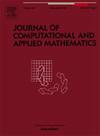Closed-form solution-based fuzzy utility vectors acquired from trapezoidal fuzzy pairwise comparison matrices using logarithmic quadratic programming for improving fuzzy AHP decision-making systems
IF 2.1
2区 数学
Q1 MATHEMATICS, APPLIED
Journal of Computational and Applied Mathematics
Pub Date : 2025-03-18
DOI:10.1016/j.cam.2025.116647
引用次数: 0
Abstract
Closed-form solution-based fuzzy utility vectors acquired from trapezoidal fuzzy pairwise comparison matrices (TFPCMs) play significant roles in examining the quality of fuzzy evaluations in TFPCMs and improving the efficiency of fuzzy analytic hierarchy process based decision-making systems. This paper introduces a concept of consistent TFPCMs and develops crucial properties to expose inherent constraints among increasing spread indices, decreasing spread indices, and core and support uncertainty indices of fuzzy evaluations in a consistent TFPCM. The paper proposes two normalization frames called core normalized trapezoidal fuzzy vectors and support normalized trapezoidal fuzzy vectors. By categorizing all TFPCMs with the same order into two groups, two logarithmic quadratic programming models are respectively built to seek normalized trapezoidal fuzzy utility vectors from TFPCMs. The two logarithmic quadratic programming models are subsequently integrated into one whose closed-form solution is identified by Lagrange multiplier method. A closed-form solution-based consistency index is presented to figure out inconsistency degrees of TFPCMs. An illustration with one consistent TFPCM and five inconsistent TFPCMs is offered to reveal the use of the presented method and a study comparing the developed model with fuzzy mean methods and fuzzy eigenvector methods is conducted to demonstrate the performance and superiority of the closed-form solution-based fuzzy utility acquisition method.
利用对数二次规划从梯形模糊两两比较矩阵中获取基于闭型解的模糊效用向量,改进模糊层次分析法决策系统
从梯形模糊两两比较矩阵(TFPCMs)中获取的基于封闭解的模糊效用向量,对于检验TFPCMs中模糊评价的质量,提高基于模糊层次分析法的决策系统的效率具有重要意义。本文引入了一致性TFPCM的概念,并给出了一些关键性质来揭示一致性TFPCM中增加扩散指标、减少扩散指标以及模糊评价的核心和支持不确定性指标之间的内在约束。提出了核心归一化梯形模糊向量和支持归一化梯形模糊向量两种归一化框架。通过将所有同阶的tfpcm划分为两组,分别建立两个对数二次规划模型,从tfpcm中寻求归一化梯形模糊效用向量。然后将两个对数二次规划模型整合为一个模型,用拉格朗日乘子法辨识其闭型解。提出了一种基于闭式解的一致性指标来计算tfpcm的不一致程度。以一个一致的TFPCM和五个不一致的TFPCM为例说明了该方法的应用,并将所建立的模型与模糊均值方法和模糊特征向量方法进行了比较,以证明基于封闭形式解的模糊效用获取方法的性能和优越性。
本文章由计算机程序翻译,如有差异,请以英文原文为准。
求助全文
约1分钟内获得全文
求助全文
来源期刊
CiteScore
5.40
自引率
4.20%
发文量
437
审稿时长
3.0 months
期刊介绍:
The Journal of Computational and Applied Mathematics publishes original papers of high scientific value in all areas of computational and applied mathematics. The main interest of the Journal is in papers that describe and analyze new computational techniques for solving scientific or engineering problems. Also the improved analysis, including the effectiveness and applicability, of existing methods and algorithms is of importance. The computational efficiency (e.g. the convergence, stability, accuracy, ...) should be proved and illustrated by nontrivial numerical examples. Papers describing only variants of existing methods, without adding significant new computational properties are not of interest.
The audience consists of: applied mathematicians, numerical analysts, computational scientists and engineers.

 求助内容:
求助内容: 应助结果提醒方式:
应助结果提醒方式:


